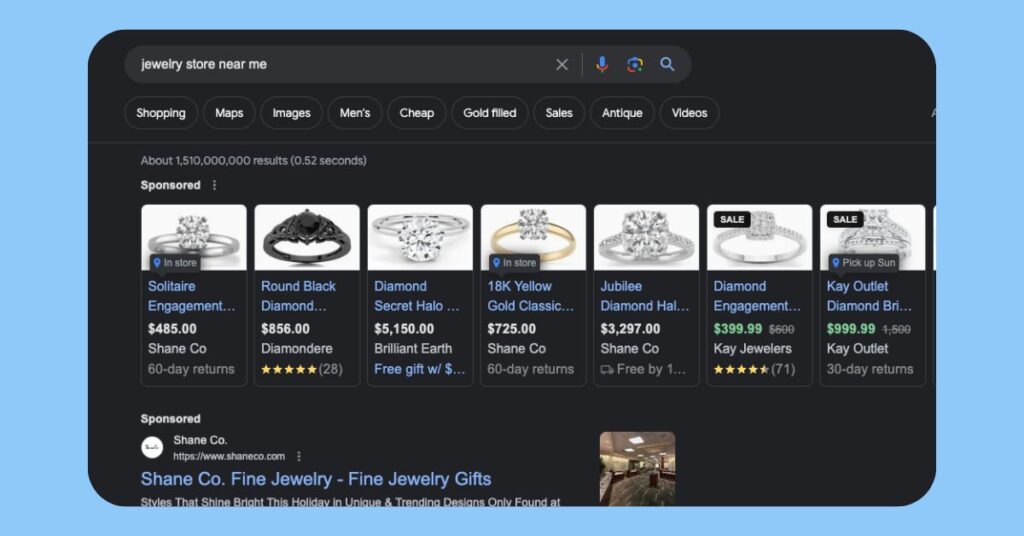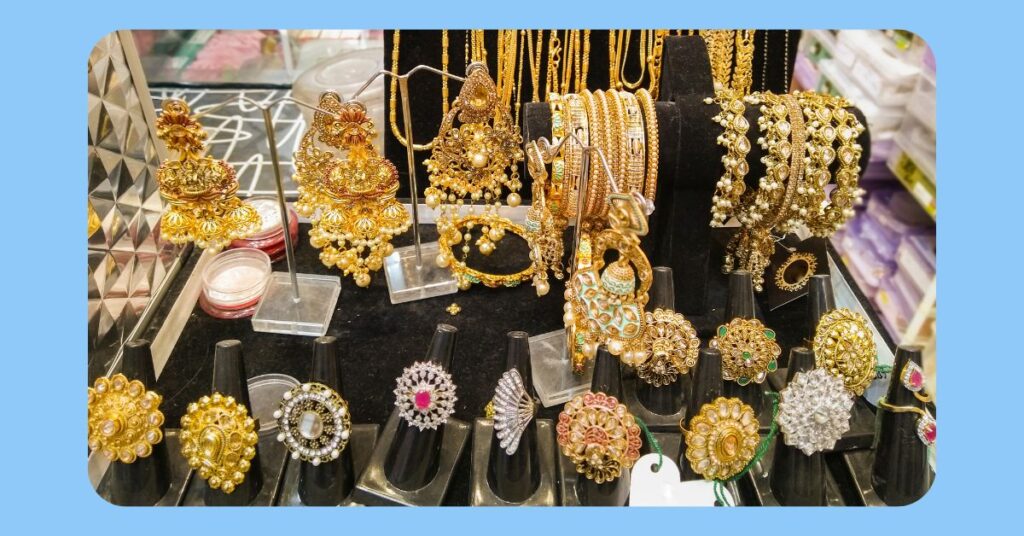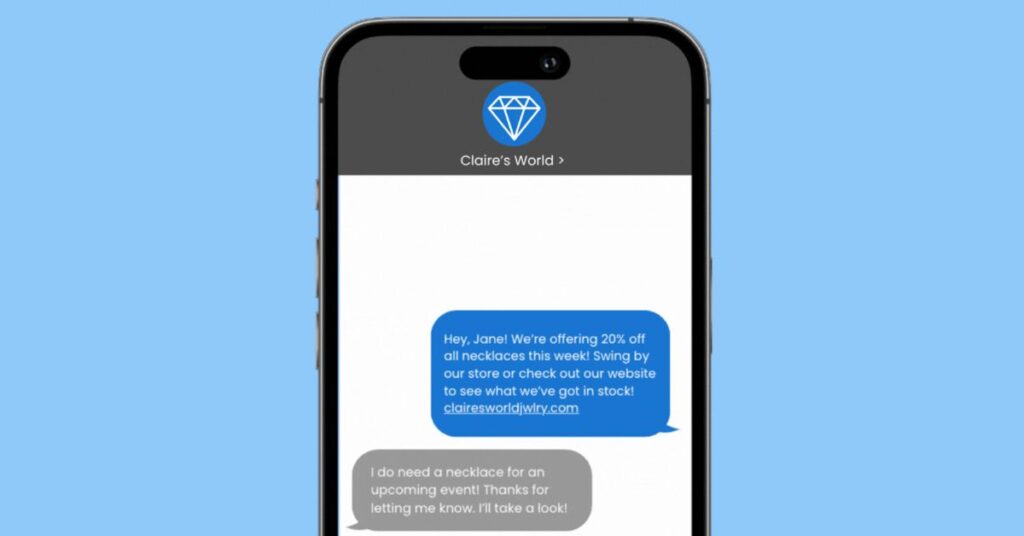Every jeweler knows that the perfect cut can turn a dull stone into a glittering, must-have piece. The right cut is crucial because it maximizes the gem’s ability to reflect and refract light and enhances its brilliance. It’s not just about shaping the stone but optimizing its proportions and angles to unlock its full potential.
In some ways, the transformative process of gem cutting is similar to the journey of jewelry store marketing. It’s about finding the right angle, displaying your shop in the perfect light, and positioning your business as a dazzling spectacle.
The tricky part is that there’s no “right” way to do it. You must get clear on who you’re marketing to, win their trust, and convince them to purchase. In this blog, we’ll explore 18 proven jewelry store marketing strategies to capture attention, strengthen your brand, and drive sales.
Table of contents
What is jewelry store marketing?
Jewelry store marketing refers to jewelry retailers’ strategies and tactics to promote their business and products, attract customers, and drive sales. This typically involves some combination of digital marketing across platforms like social media, SEO, and email, as well as real-world promotion through events, partnerships, direct mail, and in-store experiences.
Make Local Social Media Management a Breeze
Learn how Birdeye makes jewelry store marketing a breeze. Watch a demo now.
How to market a jewelry store
You’re not alone if you’re wondering how to market a jewelry store. There is no one-size-fits-all solution — different tactics will resonate better with different target audiences. However, some overarching best practices apply.
First, clearly define who your ideal customers are and where they spend their time — online and offline. For example, are you targeting middle-aged males looking for gifts for their wives? Or maybe young women seeking elegant but affordable accessories?
Once you intimately understand your audience, you can strategically show up on the platforms and channels that allow you to grab their attention.
Remember: the key is patience and persistence. Finding the jewelry store marketing mix that works for your business will likely involve experimentation. If you try a tactic that doesn’t work, don’t be afraid to pivot and try something else entirely.

18 jewelry store marketing strategies to fuel business growth
Succeeding with jewelry marketing requires a strategic combination of brand-building and customer acquisition strategies. Not sure where to get started? Below, we’ve listed proven jewelry store marketing strategies to boost your bottom line.
1. Make the right impression with your website
You’d be embarrassed if customers showed up to your physical storefront and no employees offered to assist them, the room smelled like rotten food, and everything was covered in dust, right? The same should be true for your website.
Your website is often one of the first impressions potential customers get of your business. It is the digital storefront for your business, and it should act as a visual representation of your brand. Here are a few tips to keep you on the right track:
- Put your best foot forward: Invest in a professional, polished website; a quickly hacked-together landing page won’t cut it.
- Build trust and credibility: Incorporate high-resolution imagery and integrated social proof like reviews.
- Make it easy to contact you: Offer live chat or a chatbot for instant customer support.
2. Showcase your products and boost your reach on Pinterest
With over 400 million regular users, the highly visual nature of Pinterest naturally lends itself to jewelry marketing.
Pinterest’s immersive discovery and inspirational browsing make it ideal for spotlighting designs. Consider:
- Strategically curating boards with lifestyle images styling your pieces elegantly.
- Sharing behind-the-scenes content and linking pins back to related products on your site.
- Curating holiday gift guides for specific personas.
3. Send targeted email campaigns
Unlike some forms of digital advertising, email allows for a personalized but highly targeted approach. Jewelry, an intimate and often sentimental purchase, benefits significantly from this personal touch.
To get started with email marketing, segment your customer email list by key demographics like gender and age, as well as by interests, price range purchased, and past interactions.
Then, use those data points to create campaigns that resonate with your segmented audiences. For example, if you have a new collection of engagement rings, you can target customers who have shown interest in bridal jewelry or browsed similar products on your website. Similarly, you can target segments with a history of purchasing in higher price ranges for high-end pieces.
Finally, make sure to monitor the performance of your email campaigns. Track open, click-through, and conversion rates to understand what resonates with your audience — then refine your strategy accordingly.
4. Leverage the power of social media advertising
Social media ads allow you to blend the power of visual appeal with the precision of targeted marketing. By running paid ads on platforms like Instagram, Facebook, Pinterest, and TikTok, you can guide traffic to specific product pages.
Sending traffic to specific pages of your website is especially beneficial for showcasing individual pieces or collections. It allows for a seamless shopping experience — potential customers move effortlessly from admiring a piece in an ad to learning more about it on your website and, if you’re lucky, making a purchase.
5. Get found in local searches with SEO
Nearly half of all searches on Google have local intent. When your target audience searches for products like yours online, does your business show up? If not, you’re missing out on tons of potential customers.
Local search engine optimization (SEO) is the process of optimizing your business’s online presence to attract more customers from relevant local searches, typically on search engines like Google. This strategy is an essential part of digital marketing for jewelry stores.
If you’re new to the world of SEO, here are a few tips to get you started:
- Claim and optimize your Google Business Profile: Ensure your business information is accurate and up-to-date, upload high-quality photos of your store and products, and use the Q&A feature to answer common questions.
- Use local keywords: Incorporate terms into your content that local customers might use to find your products, such as “jewelry store in [your city]” or “[your city] engagement rings.”
- Optimize your site for mobile: Ensure your website is mobile-friendly, as many local searches are conducted on mobile devices.

6. Create a recognizable brand identity
Brand identity encompasses the visual elements of your brand, such as logo, color scheme, design, and overall aesthetic. It also includes voice, tone, and the values that your brand represents. Your brand identity plays a massive role in how customers perceive you and goes a long way in building a solid community.
In the jewelry industry, where purchases are driven by emotion and personal taste, having a distinct and appealing brand identity can be the deciding factor for customers.
To enhance brand identity, start by cultivating a consistent visual language across all platforms — from your storefront and product packaging to your website and social media profiles. This consistency helps in building brand recognition.
For example, Tiffany & Co. is renowned for its distinctive robin’s egg blue boxes. This color makes their packaging instantly recognizable and evokes a sense of luxury and exclusivity.
7. Increase ROI with Google Seller Ratings
Google Seller Ratings showcase your business’s average rating alongside your text ads. These ratings range from 1-5 stars and are based on factors like your volume of reviews, authenticity, customer feedback, and more.

To get started with Google Seller Ratings, first, you must qualify through a certified partner like Birdeye. Additionally, you’ll need to meet the following criteria:
- Quantity of reviews: You must have gathered at least 100 reviews over the past 12 months.
- Quality of reviews: Google wants you to have an average rating of 3.5 out of 5 stars or higher.
- Website check: Google will check your website to verify that your business is legitimate and complies with their policies.
8. Implement strategic content marketing
Content marketing is another essential part of digital marketing for jewelry stores. It’s not just about creating and sharing content; it’s about crafting valuable, relevant, and consistent content that attracts and engages your target customers.
Content marketing can take many forms for jewelry businesses, from blog posts discussing the latest trends in jewelry design to social media posts showcasing the craftsmanship behind each piece. You could create video content that offers practical advice on jewelry care or develop content around customer stories or testimonials. The possibilities are endless.
As you get started, remember: Effective content marketing is a long-term strategy that requires patience and persistence, but the payoff in brand loyalty and customer engagement can be substantial.
9. Host giveaways and contests
Hosting creative giveaways and contests is a powerful way to boost engagement and create buzz around your brand. People naturally enjoy the excitement and opportunity of winning something, which makes these kinds of campaigns an effective way to stimulate engagement, increase social media buzz, and gather email sign-ups.
Consider offering a unique prize that aligns with your brand, like a year’s supply of professional jewelry cleaning or a custom jewelry design experience. To maximize the reach of your giveaway, require participants to share the contest on social platforms such as Instagram and Facebook.
10. Find opportunities to be featured in local media
Being featured in gift guides, fashion shoots, or editorial articles can position your jewelry brand as a leader in the industry and enhance your reputation and desirability. It’s about leveraging the power of storytelling and the influence of established media platforms to reach a wider yet targeted audience.
To secure these valuable spots, it’s crucial to proactively pitch to local media outlets, offering something unique and compelling that aligns with their content and audience interests. This could include exclusive behind-the-scenes images, details about the craftsmanship that goes into your jewelry, or stories about the inspiration behind your collections.
11. Participate in local events
Participating in local events like craft fairs, festivals, and holiday markets increases your brand’s visibility and allows you to build a loyal and close-knit local customer base.
Having knowledgeable jewelry consultants present at these events is critical. They play a crucial role in educating visitors about your products and sharing stories about the craftsmanship, materials, and inspiration behind each piece. This helps build a connection with potential customers and establishes your brand as knowledgeable and trustworthy.
Offering event-exclusive pieces or discounts encourages on-site purchases. It creates a sense of exclusivity and urgency, encouraging attendees to make a purchase decision while at the event.

12. Launch exclusive collaborative collections
Collaborating with complementary brands and influencers to co-design unique jewelry collections offers multiple benefits. It allows for creative synergy, combining different styles and strengths to create something unique.
Moreover, the limited nature of these collections adds to their appeal — people love an exclusive product. This sense of exclusivity can drive demand and urgency, creating a buzz around the launch and encouraging quick purchases.
And the cherry on top? By tapping into the partner’s audience, you expand your brand’s reach beyond your existing customer base.
But remember: such partnerships are not just about product creation but about storytelling and shared values. Be sure to collaborate with people and companies who share your values and will resonate with your current customers.
13. Offer curated jewelry subscription boxes
Offering curated jewelry subscription boxes involves sending customers jewelry tailored to their preferences, past purchases, or special occasions. These boxes can be sent on a monthly or quarterly basis.
Offering a subscription not only provides a steady stream of recurring revenue for your brand but also introduces customers to new pieces they might not have discovered otherwise.
14. Enable virtual try-ons
There’s nothing worse than ordering something online only to receive it and realize you don’t like it as much in person. As a customer, you must go through the hassle of initiating a return. As a business, you have to deal with the lost sale.
Your jewelry brand can reduce purchase friction and return volume by implementing virtual try-on augmented reality technology and allowing shoppers to digitally preview select jewelry styles on their own hands or necklines. This interactive experience gives customers the confidence they need to purchase jewelry online without physically visiting a store.
15. Create “snackable” social videos
Snackable content is quick and easy to consume and share — think reels, TikToks, YouTube shorts, memes, and infographics. The appeal of this jewelry store marketing strategy lies in its brevity and impact; this short-from content can capture your audience’s attention and convey a message or showcase a product in just a few seconds.
In the context of jewelry marketing, this could involve showcasing a sparkling new piece in various lights, sharing quick jewelry styling tips, or even offering a brief glimpse into the craftsmanship process behind the scenes.
To maximize the impact of snackable content, focus on high-quality visuals and creativity. Incorporating trending audio and participating in popular challenges can also increase the reach of these posts.
16. Drive engagement through text message marketing
Text has the highest open rate of any channel — roughly 98% of texts get opened. Because of this, SMS marketing is one of the most effective channels for reaching customers.
Text marketing can boost customer engagement, too. Whether you’re alerting customers to sales, announcing new arrivals, or sending birthday specials, the intimate, conversational approach of text messages often results in higher engagement levels than other channels.
Here are a few best practices to keep in mind:
- Tailor messages based on individual preferences, purchase history, and special dates.
- Ensure texts are short and to the point, delivering your message clearly and effectively.
- Send texts at reasonable hours, respecting your customers’ time and privacy.
- Include a clear call-to-action in your messages — tell customers what to do next.

17. Launch a customer referral program
A referral program is a strategy that encourages loyal customers to recommend your products or services to friends and family, often offering incentives for both the referrer and the referee.
It’s a simple yet effective strategy — by encouraging satisfied customers to recommend your brand to friends and family, you tap into a vast network of potential customers.
A successful customer referral program hinges on its simplicity and attractiveness. The process should be straightforward — make it as easy as possible for your customers to share your brand with their friends and family. And, of course, be sure to track and reward referrals promptly to maintain enthusiasm and trust in the program.
18. Collect and manage reviews
We saved the best digital marketing for jewelry stores strategy for last. A whopping 93% of consumers say online reviews impact their purchasing decisions, making this tactic potentially the most impactful one on the list.
Start by streamlining the process for customers to leave reviews. After a purchase, consider sending a review request via text message. Ensure the process is as simple as possible by including a direct link to where the customer should leave their feedback.
Equally important is review management. Ensure that each review — positive or negative — receives a professional and appreciative response. Thanking customers for their feedback demonstrates your commitment to customer satisfaction and shows potential customers that you value and actively engage with your client base.
Jewelry store marketing FAQs
To advertise your jewelry store effectively, create an engaging website, actively use social media platforms for promotions and engagement, implement targeted email marketing campaigns, enhance your local and organic SEO, and consider trying traditional advertising methods like local billboards.
Customer service and product quality are the keys to winning over your target buyers. Make your jewelry business stand out by identifying and focusing on a unique niche, investing in innovative and appealing packaging, and offering exceptional customer service that differentiates you from competitors.
Promote your jewelry business through digital channels like your website, social media (like Instagram and Pinterest), and email and text marketing. Additionally, consider online marketplaces like Amazon and eBay and physical marketing strategies like signage and promotional offers at your store location.
Polish your presence with Birdeye
Knowing how to market a jewelry store is one thing, but implementing your plan is another thing entirely. You need the right tools in your tool kit to come out on top.
Birdeye helps jewelry brands like yours elevate their online visibility and reputation, communicate with customers, and increase sales. Our all-in-one solution makes it simple to manage listings, collect and respond to reviews, manage referral programs, automate messaging, and more.
Ready to see what all the hype is about? Watch a demo today.

Originally published









